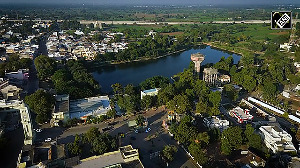Predictions" are being made about the course of inflation in the country. Some official economists and ministers say that a decline would take place in three months. However, a disinterested analysis of data and trends reveals that the scenario is not so rosy.
A study of the Wholesale Price Index (WPI) during 2007-08 shows certain interesting features that have a bearing on the inflation rate in the current year. Although everyone recognises the limitation of WPI, it is still is important since it is the basis for policy decisions.
From March 31, 2007 through March 29, 2008, the index went up from 210.4 to 226.0 - an increase of 7.4 per cent. But, between the end of March 2007 and the end of summer (June 30, 2007), WPI rose only by a small extent, to 212.8. In fact, the index number maintained the subdued trend in growth for a much longer period.
But, given the fast-changing world we are living in, it is better to look ahead for only a quarter through the long hot summer for forecasting.
The trend in the index shows that, even if prices stabilise at the current level, the annual rate of inflation will continue to be around 7 per cent. The latest WPI is 227.5 for all commodities, as on April 19, 2008.
If we assume that it will remain at this level, which by itself could provide some relief to consumers, the annual inflation rate would still be ranging between 7.5 per cent and 6.9 per cent till the end of summer. For this rate to fall, it is, therefore, necessary that there is an absolute decrease in WPI hereafter. What are the prospects for such a fall?
A more disaggregated analysis reveals the following features of the level of index numbers at the end of March 2007 and end of June 2007 for major groups and for commodities of mass consumption (see table). The latter has, of course, small weights.
|
WPI at the end of | ||
|
|
March '07 |
June '07 |
|
1. Primary articles |
215.9 |
222.3 |
|
(i) Food articles: |
214.2 |
221.2 |
|
(ii) Rice: |
184.1 |
187.0 |
|
(iii) Wheat: |
222.5 |
218.9 |
|
(iv) Pulses: |
253.2 |
248.7 |
|
(v) Vegetables: |
180.0 |
247.1 |
|
(vi) Milk: |
202.7 |
209.2 |
|
2. Fuel, power, light and lubricants: |
320.1 |
322.0 |
|
3. Manufactured products: |
184.0 |
185.1 |
|
(i) Sugar: |
148.9 |
141.0 |
|
(ii) Edible oils: |
163.5 |
170.1 |
Except for wheat, pulses and sugar, the last a partly controlled commodity, all the others did not record any fall in prices during summer. The exceptions are understandable as they follow the harvest or the crushing season for cane, as the case may be. The time series needs to be broken into trend, seasonal, cyclical and random components to understand their underlying factors.
The RBI publishes the seasonal factors periodically for different variables. The latest one relating to 1995-96 to 2006-07 was published in the Reserve Bank of India Bulletin of September 2007.
What one can see from a quick analysis of the data is that, with a few exceptions, seasonal factors are getting increasingly blurred. There is not that sharp a difference between "seasons" in major variables now, as was observed, say, four decades ago.
The RBI used to argue till recently that seasonality was still prevalent in the economy. But one close look at the data would reveal that the difference between the so-called busy and slack seasons is one of Tweedledum and Tweedledee, so far as prices are concerned.
During the period covered, the WPI for all commodities had an average range of 1.4 in the seasonal factor with a low standard deviation of 0.2. In the past, kharif was the major season accounting for the bulk of agricultural commodity production. Now rabi is more or less as important as kharif season in terms of contribution to output, especially foodgrains.
This is a result of increased irrigation facilities over the years and the diversification of agriculture as also the opportunities available for exports. So far as manufacturing is concerned, in the past many dominant industries relating to cotton and jute textiles, food processing, and so on, which were agro-based, had certain seasonality associated with agriculture.
Now with the emergence of rabi season as a significant contributor to agricultural production and, more importantly, the development of a number of industries like petroleum products, engineering goods, gems and jewellery, chemicals and pharmaceuticals and information technology, which are not agro-based, the economy is busy throughout the year.
Some time ago, the RBI recognised this change in the situation and initiated the practice of quarterly analysis of developments in the economy and policymaking instead of on the basis of busy and slack seasons. It may, however, be too shy to admit that seasonality is not as relevant now as before in view of its past stand on the subject.
As for trend, there is no doubt that there is a continuous shift in the demand curve for several commodities to the right, particularly, for foodgrains and vegetables, thanks to improvement in incomes and living standards.
Changes in food habits are another factor. Cycles of a general nature have not been established so far in the literature, although one sees the working of a cobweb cycle in sugarcane with years of surplus followed by those of deficit.
The index for fuel is not likely to change much in an election year. It will certainly not fall. The government will continue to shirk the decision to effect the passthrough in oil prices.
As for manufactured products, it would be a Herculean task for the producers of most of the commodities to effect price reductions in the context of the substantial increases in the prices of raw materials and wages during the last year.
The consumer is concerned with what he pays for goods and services at the market, not with any technical analysis of seasonal factors and trends. The question was raised earlier: would there be declines in prices and inflation rate?
It is going to be difficult to achieve. There is some softening of price in the case of edible oils, thanks to imports. Summer is known for poor arrivals of vegetables and hence not much relief can be expected on that front.
If a vegetable like capsicum sells at the price of mangoes, it is a great mercy if it does not go up further! If the price of a banana does not increase beyond Rs 2 per piece, it would be some relief as it constitutes 'lunch' for many people.
An ordinary Udipi restaurant classified as Grade III in Mumbai is now beyond the reach of many who can only look at it wistfully! Prices there have gone up further ever since the Value Added Tax of 12.5 per cent was levied, making the lives of many single men in metropolitan areas difficult.
The government can act only in respect of certain commodities for administrative action to improve supplies. It cannot handle the problem of supplies of, say, vegetables and fruits.
It can keep the prices of rice, wheat and pulses under control by releasing its stocks that remain surplus after meeting PDS and other commitments, for sale on a no-profit no-loss basis through cooperative consumer stores and responsible retail establishments. Auctioning the sales of rice or wheat to private wholesale trade will be self-defeating.






